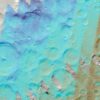A team of scientists has unveiled a novel method for the early estimation of coronal mass ejection (CME) direction in 3D space. The groundbreaking technique, named DIRECD—”Dimming InfeRred Estimate of CME Direction”—will provide crucial data to mitigate potential adverse impacts on various industries and technological systems both in space and on Earth.
The findings of the study, conducted by the international team will be published in the published in Astronomy & Astrophysics. Meanwhile, the research paper is already accessible via the arXiv preprint repository.
Coronal mass ejections are giant magnetic plasma bubbles that are ejected from the sun into the surrounding space at speeds of several hundred to several thousand kilometers per second. If the bubble of charged particles is directed toward Earth, it may cause geomagnetic storms and polar auroras when hitting the Earth’s magnetosphere, which can lead to serious problems in the operation of space- and ground-based technological systems and create radiation hazards for astronauts.
Unfortunately, early detection of a coronal mass ejection is currently very challenging, as typically, it becomes visible only at a developed stage, when it appears in the field of view of special instruments, called coronagraphs, which create an artificial solar eclipse by occulting the solar disk by several of its radii. In addressing this challenge, to estimate the propagation direction of a coronal mass ejection in 3D space early on, the DIRECD method uses indirect traces of coronal mass ejections on the sun—coronal dimmings, which are dark areas in extreme ultraviolet images.
Dimmings are caused by the expansion and ejection of matter from the solar corona during a CME. The current research and the DIRECD method resulted from an earlier work, where the team showed the connections between the dimming and CME morphology, demonstrating the great potential of coronal dimmings for detecting and analyzing CMEs at an early stage in their evolution.
Shantanu Jain, a Skoltech Ph.D. student and the lead author of the study, expressed enthusiasm about the method’s capabilities, stating, “Our method can provide early insight into the propagation direction of the CME even before it is observed by coronagraphs on board satellites. It is amazing that we can accurately estimate 3D parameters of the CME such as 3D direction with just 2D dimming information extracted from solar images at a very early stage of the solar eruption.”
“The technique will be particularly useful for Earth-directed events, addressing challenges associated with assessing them from coronagraphs based in the sun-Earth line, as they mainly observe CME expansion rather than propagation. Right now we are approaching the maximum of the 11-year solar cycle and we should expect to see more sunspots, solar flares, and coronal mass ejections bursting out from the sun,” added Skoltech Associate Professor Tatiana Podladchikova, a co-author of the study.
This pioneering research opens up new avenues for advancing space weather prediction capabilities, offering potential benefits for industries reliant on satellite communication, airlines, power grids, communications, transportation, pipelines, and emergency services. As solar activities continue to play a crucial role in our interconnected technological systems, the DIRECD method provides an important tool for enhancing our ability to forecast and mitigate the impacts of solar storms.
The research was done in collaboration with researchers from NorthWest Research Associates, the University of Graz and its Kanzelhöhe Observatory.
More information:
Shantanu Jain et al, Coronal dimmings as indicators of the direction of early coronal mass ejection propagation, Astronomy & Astrophysics (2023). DOI: 10.1051/0004-6361/202347927. On arXiv: DOI: 10.48550/arxiv.2311.13942
Provided by
Skolkovo Institute of Science and Technology
Citation:
New method spots cosmic threats by extracting 3D direction of plasma ejections from sun’s 2D ultraviolet images (2024, February 5)



